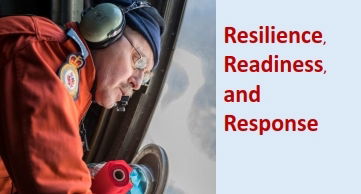New Report explores the growing demand for military involvement in climate emergencies worldwide

Brussels / The Hague - 30 July 2025
A groundbreaking new report, "Resilience, Readiness, and Response," from Project CASA (Climate and Security Action through Civil-Military Cooperation in Climate-Related Emergencies) highlights the increasing and essential role of national militaries in addressing the escalating global climate crisis.
The report is the result of a comprehensive two-year study which provides the first cross-national dataset on military involvement in climate disasters. Edited by Ronald A. Kingham and Dr. Ashley McIlvain Moran and published by the Environment & Development Resource Centre (EDRC), the report serves as both a critical resource and a call to action for policymakers and practitioners grappling with climate-worsened disasters.
The report underscores that the frequency and intensity of extreme weather events, such as wildfires, floods, and hurricanes, have dramatically surged in recent decades, placing unprecedented demands on both civilian and military authorities. For instance, the World Meteorological Organization (WMO) notes a five-fold increase in climate-related disasters between 1970 and 2019, resulting in over 2 million deaths and US$3.64 trillion in economic losses. More recently, the United States alone experienced a historic US$ 28 billion weather and climate disasters in 2023, surpassing previous records and costing the U.S. military US$2.6 billion across 393 deployments. Such figures represent an accelerating systemic crisis where the rate of climate impact is outstripping current adaptive and response capacities.
Militaries, with their unique capabilities, are stepping up to fill critical gaps. Their logistical expertise, rapid mobilization capabilities, and experience operating in high-stress environments make them indispensable partners in emergency response efforts. While foundational international guidelines like the Oslo Guidelines traditionally suggested military assets be used as a "last resort," the escalating scale of climate-related emergencies increasingly challenges this principle, leading to a de facto normalization of military involvement.

>>> READ MORE AND DOWNLOAD THE REPORT >>>
Project CASA: Bridging the Data Gap
Project CASA was launched in June 2023 by a Coordinating Group comprising representatives from five partner organizations: the Climate Security Association of Canada (CSAC), Crisis Management and Disaster Response Centre of Excellence (CMDR COE), Environment & Development Resource Centre (EDRC), Foundation for Global Governance and Sustainability (FOGGS), and Global Military Advisory Council on Climate Change (GMACCC). The project originated from a recognized need for coherent data on military involvement in natural disasters to improve civil-military response.
The project's key objectives include examining trends in military responses over time, assessing the resources and mechanisms militaries use, and analyzing the consequences for force composition and readiness. To achieve this, Project CASA has developed several novel analytical products:
- Country Profiles: Detailed insights into civil-military cooperation in climate emergencies across 19 countries, including legal frameworks, operational strategies, and training.
- International/Intergovernmental Organization (IGO) Profiles: Descriptions of 25 international entities involved in climate security, risk reduction, and response.
- A New Dataset: A systematic framework to track military involvement in climate-related emergencies, addressing the significant lack of such data globally.
- A Typology of Civil Protection Activities: Categorizing military involvement across prevention, preparedness, response, and recovery phases.
Diverse Approaches to Civil-Military Cooperation
The study reveals a wide spectrum of approaches among countries regarding military involvement in climate emergencies.
- Legal and Policy Frameworks: Some countries, like Bangladesh and Sweden, rely on general national disaster frameworks without specific military guidelines, while others, such as Hungary, Ireland, and Italy, have extensive laws and military policies. Belgium, Brazil, Bulgaria, Canada, France, Latvia, Mexico, Romania, Spain, Switzerland, and the United States have robust legal frameworks and military guidelines covering climate change mitigation, adaptation, and disaster response. Croatian Armed Forces is currently developing a climate change mitigation and adaptation plan which it expects to adopt by the end of 2025.
- Operational Frameworks: Approaches range from training specialized personnel within regular units (e.g., Romania, Italy, Pakistan) to creating specialized stand-alone units (e.g., France, Spain, Bulgaria, Canada's DART) or engaging the full military (e.g., Bangladesh, Ireland, Sweden). Brazil even utilizes "dual-use" units for both civil protection and general military missions.
- Military Training: Training varies from specific tasks like search and rescue or CBRN hazards for specialized personnel (e.g., Croatia, Ireland, Latvia) to full-force training on civil protection generally (e.g., Bangladesh, Sweden). Notably, some countries like Canada, France, and Spain maintain permanent training schools for natural hazard response.
- Roles and Responsibilities: Militaries are most often involved in the early stages of emergency response, providing services like firefighting, flood response, and immediate relief, engineering, and security. Civilian agencies typically focus on longer-term processes such as prevention, preparedness, and recovery. However, there is variation in who handles search and rescue, medical assistance, and infrastructure restoration. Many countries emphasize that military engagement is at the request of civilian authorities, maintaining civilian primary responsibility.
- International Coordination: The report identifies wide participation in mechanisms like the EU Emergency Response Coordination Centre, NATO Euro-Atlantic Disaster Response Coordination Centre, and the UN Office for the Coordination of Humanitarian Affairs. Countries like Bangladesh and Pakistan also participate in UN Peacekeeping Operations and regional organizations.
Advantages and Disadvantages of Military Contributions
The report identifies both benefits and drawbacks of significant military involvement in civil protection.
Advantages:
- Rapid Mobilization and Deployment: Militaries can quickly move personnel and equipment to affected areas.
- Logistical and Engineering Capacity: They possess significant resources for transportation, infrastructure repair, and setting up temporary facilities.
- Operating in Austere Conditions: Militaries are trained to function effectively in difficult terrain and high-stress environments.
- Positive Public Perception and Morale: Involvement in disaster response boosts public trust and enhances troop morale.
- Skill Sharpening: These operations offer valuable opportunities to refine core military skills like command and control and interagency coordination in a real-life, non-combat setting.
Disadvantages:
- Diversion from Core Missions: Increased involvement risks undermining the military’s primary responsibility of national defense, potentially diverting resources and personnel.
- Strain on Personnel and Equipment: Frequent deployments can lead to fatigue, stress, and wear and tear on resources.
- Potential for Critical Gaps: Over-reliance on the military could create vulnerabilities if civilian agencies are not adequately prepared to handle major disasters independently.
Civilian agencies offer distinct advantages, including closer ties to local communities, specialized expertise in social services and psychosocial support, and a longer-term perspective focused on prevention, preparedness, and economic development. The report emphasizes the critical role of citizens themselves as the "first line of defense".
The Imperative for Better Data and Coordination
A central finding of Project CASA is the severe lack of systematic, cross-national data on military involvement in climate emergencies. Current international reporting mechanisms, like the OECD DAC, significantly undercount military outlays in disaster response, particularly for domestic emergencies. For example, a pilot study using U.S. data showed that OECD data captured only 18 U.S. military responses to climate emergencies in developing countries from 2012-2022, costing $24.9 million, while national FEMA data revealed 3,060 domestic responses costing $14.8 billion over the same period.
The report concludes with several key recommendations for action at national and international levels:
- Track Detailed Military Response Data: National governments should systematically collect and publish detailed data on all domestic and foreign emergency responses, including crisis type, response activities, and dates.
- Compile Cross-National Data: International organizations like the OECD, NATO, EU, or UN bodies should enhance data collection to provide a more comprehensive global picture of military involvement in climate emergencies.
- Enhance Integration of Response Data: Incorporate environmental, public health, and security indicators, leveraging diverse sources from scientific data to indigenous knowledge.
- Integrate Strategic Climate Intelligence: Shift from reactive to proactive approaches, using foresight and scenario planning to anticipate cascading risks.
- Promote Participatory Scenario Planning: Involve diverse stakeholders, including military, civilian, and community members, in scenario development.
- Prioritize Collaborative, Interdisciplinary Approaches: Establish formal governance structures and interdisciplinary training for improved coordination and culturally sensitive engagement.
- Strengthen Civil-Military Partnerships Throughout the DRR Cycle: Emphasize military involvement in preparedness, mitigation, and recovery, fostering trust with CSOs and local communities.
- Facilitate Learning and Exchange: Convene international forums to share lessons learned and good practices across countries and international mechanisms.
In essence, the report argues that effective cooperation, coordination, and information sharing among all levels of government, the military, local communities, civil society organizations, and international humanitarian organizations are paramount to addressing the growing climate crisis. Project CASA aims to stimulate further study and interaction to meet this defining challenge of our time.
Project CASA is led by a Coordinating Group composed of 10 representatives from the five Partner Organizations:

- Climate Security Association of Canada (CSAC),
- Crisis Management and Disaster Response Centre of Excellence (CMDR COE),
- Environment & Development Resource Centre (EDRC),
- Foundation for Global Governance and Sustainability (FOGGS), and
- Global Military Advisory Council on Climate Change (GMACCC).
With the participation of the Project CASA Advisory Group and Expert Group.
 | Project CASA is supported by the Directorate of Strategic Coordination and Outreach of the Canadian Department of National Defence through its Mobilizing Insights in Defence and Security (MINDS) Program and by the NATO Climate Change and Security Centre of Excellence (CCASCOE) |  |
Image credit: Sergeant André Hotton, a search and rescue technician, prepares to release marker streamers from a CC-130 Hercules aircraft on a 2018 exercise. PHOTO: 14 Wing / Government of Canada News Article / October 13, 2020